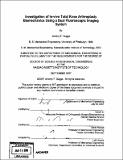Investigation of in-vivo total knee arthroplasty biomechanics using a dual fluoroscopic imaging system
Author(s)
Suggs, Jeremy F. (Jeremy Floyd), 1976-
DownloadFull printable version (22.71Mb)
Other Contributors
Massachusetts Institute of Technology. Dept. of Mechanical Engineering.
Advisor
Guoan Li and Derek Rowell.
Terms of use
Metadata
Show full item recordAbstract
While contempary total knee arthroplasty has been successful in improving the quality of life for those suffering from severe osteoarthritis, the function of these patients has not reached normal levels for their age group. Thus, there is an increasing need to improve total knee arthroplasty techniques to allow patients to function normally. We currently have limited knowledge about how current knee arthroplasties behave in-vivo, but this information could be pivotal in designing new implants and surgical techniques. Therefore, the objective of this work was to develop the Dual Fluoroscopic Imaging System, a non-invasive imaging system capable of measuring in-vivo knee kinematics in all degrees of freedom. This system was used to investigate factors that may affect patient function after total knee arthroplasty. The feasibility of using kinematic data obtained using this system to analyze wear of the polyethylene insert was also explored The system was shown to be repeatable and accurate in determining the pose of the TKA components in all degrees of freedom. Six degree-of-freedom kinematics and articular contact motion were measured in-vivo. Data was obtained for patients with two typical classes of TKA, cruciate-retaining and cruciate-substituting, and the function of conventional implants was compared to that of more recent high flexion designs. In general, no differences were detected between these groups. Further, no factors such as age, weight, PCL management, or kinematics, were found to correlate with flexion capability. Future studies should investigate changes in knee structures from the preoperative state to the postoperative state. Preliminary estimates of polyethylene stresses suggested great potential in using the Dual Fluoroscopic Imaging System in developing a model of in-vivo polyethylene wear.
Description
Thesis (Sc. D.)--Massachusetts Institute of Technology, Dept. of Mechanical Engineering, 2007. Includes bibliographical references (p. 240-271).
Date issued
2007Department
Massachusetts Institute of Technology. Department of Mechanical EngineeringPublisher
Massachusetts Institute of Technology
Keywords
Mechanical Engineering.